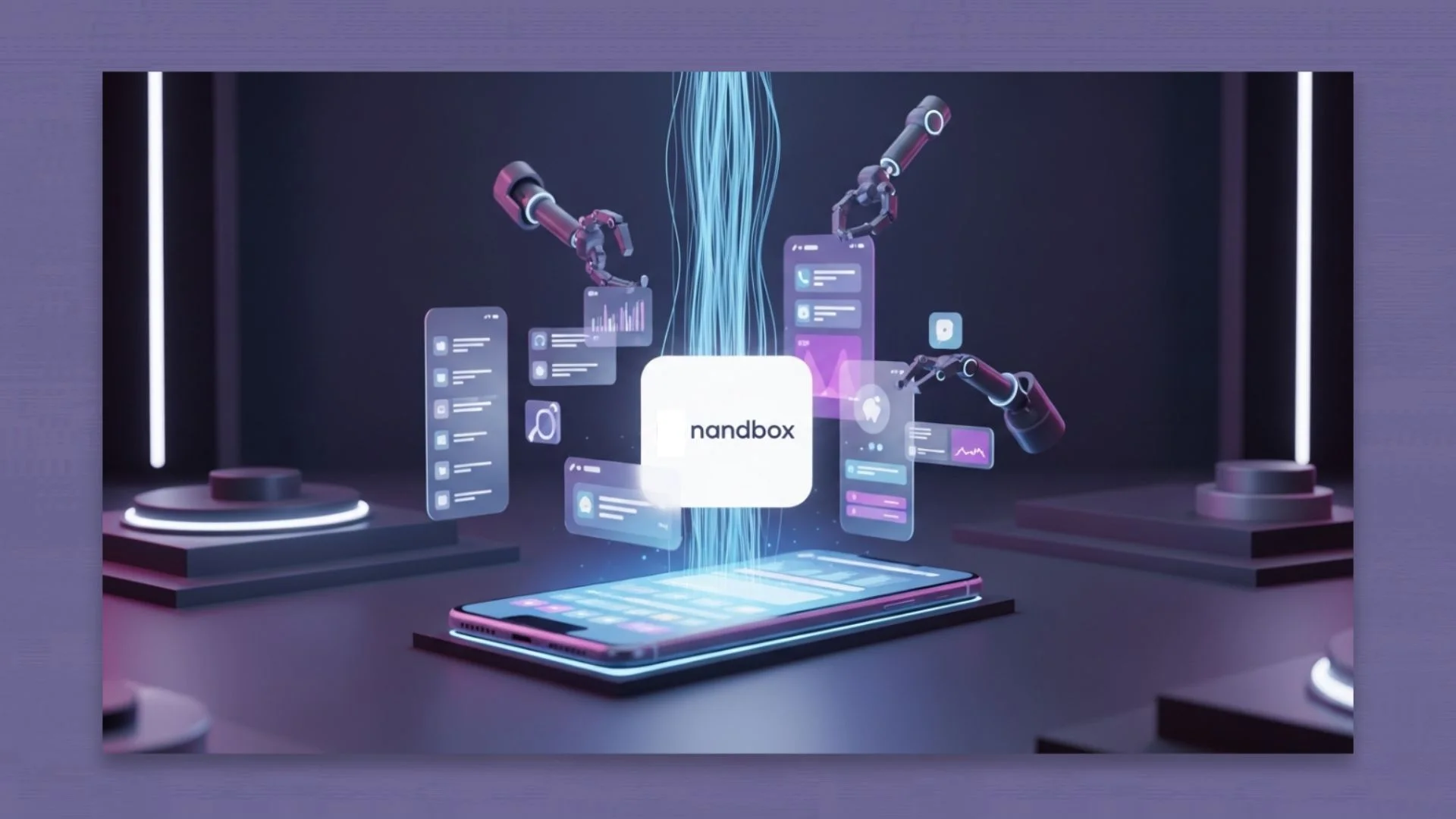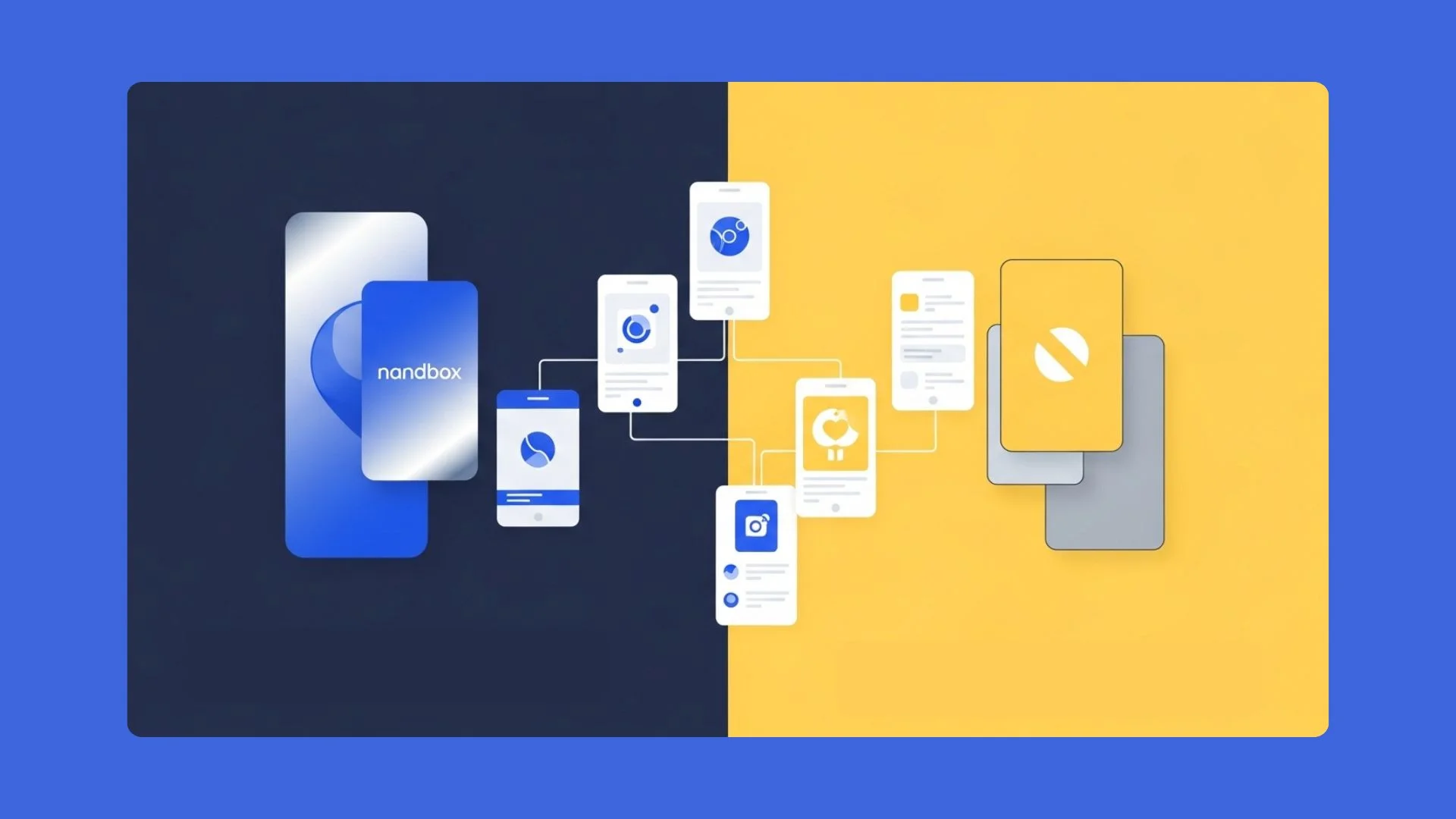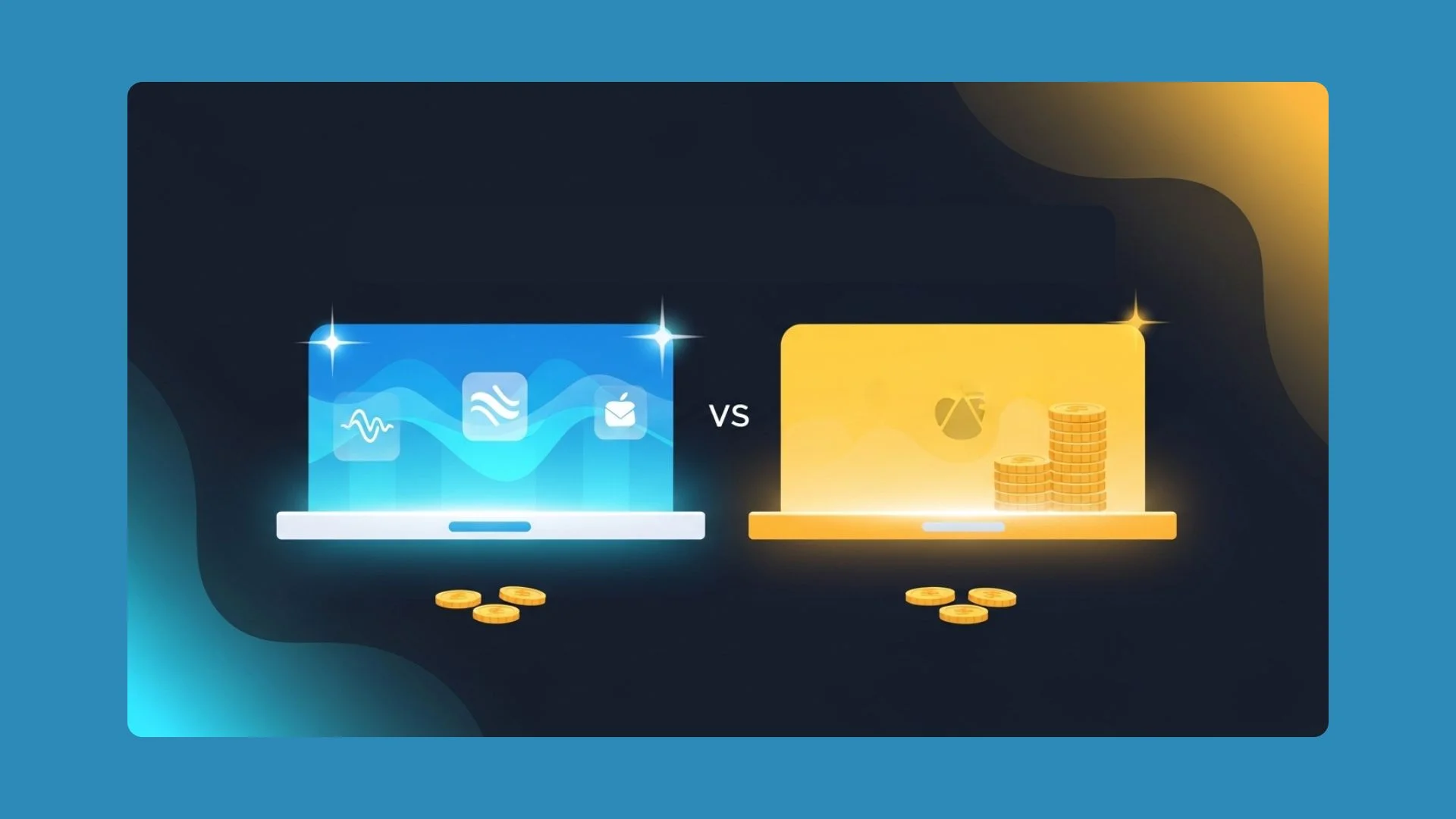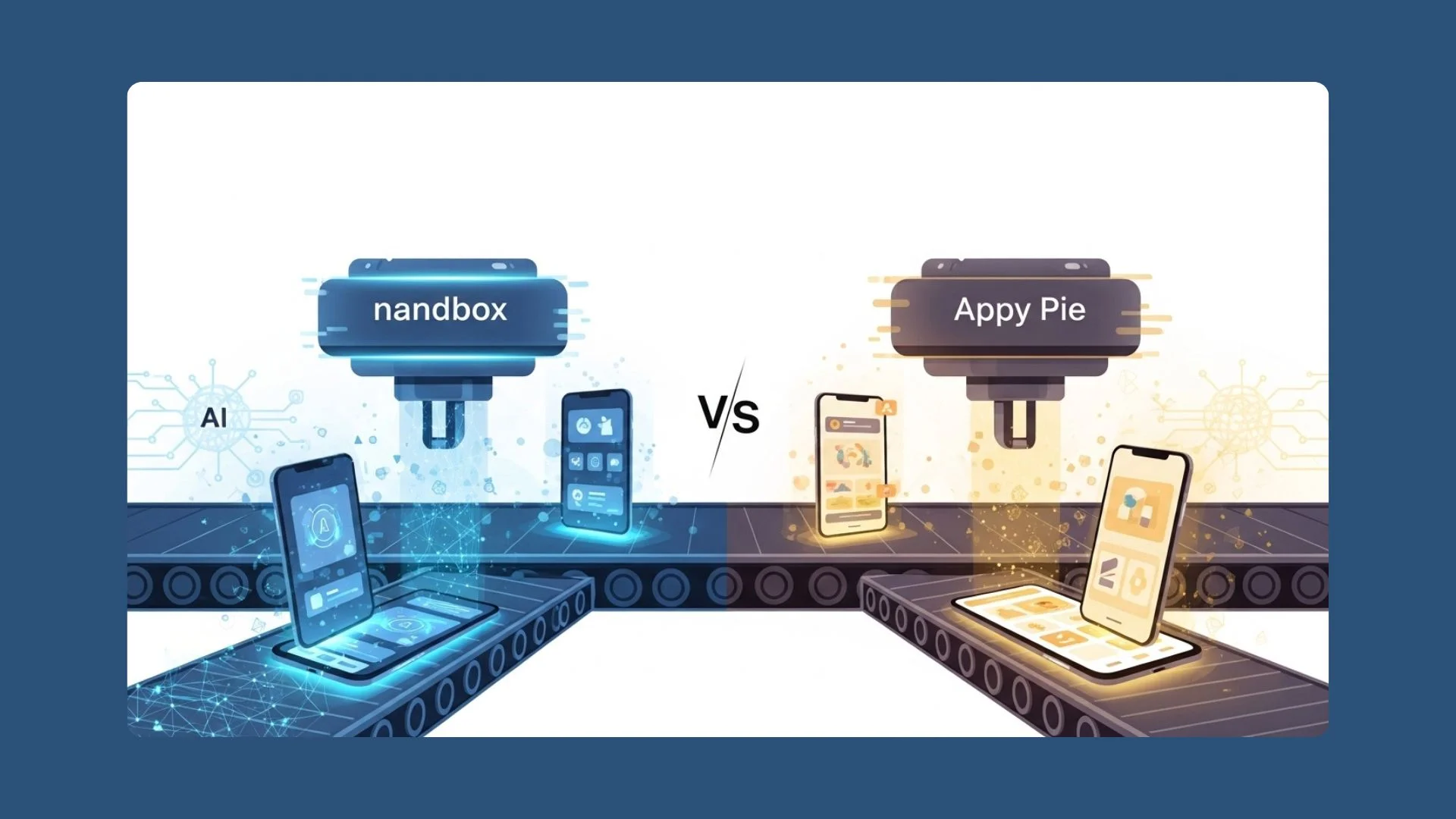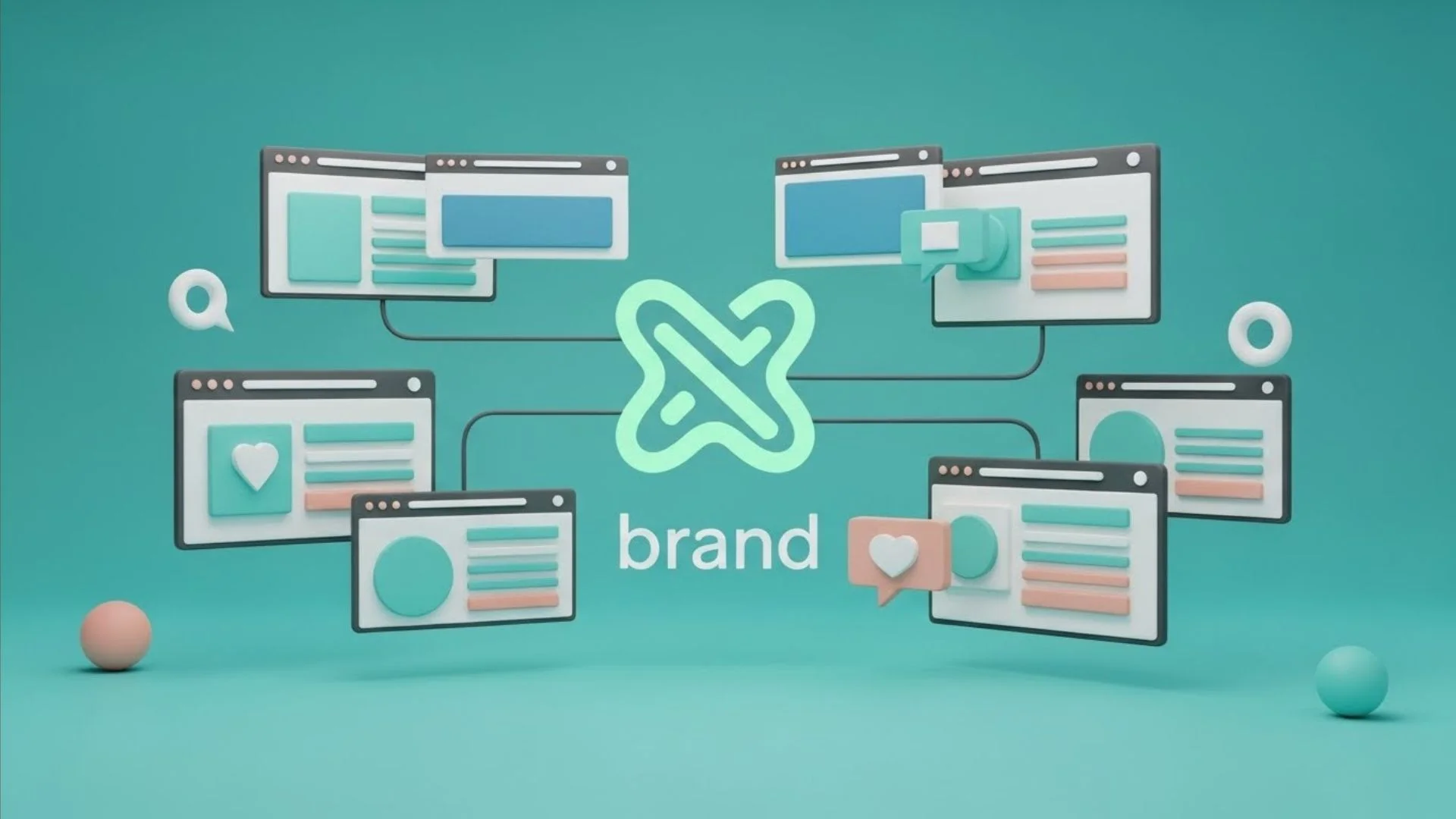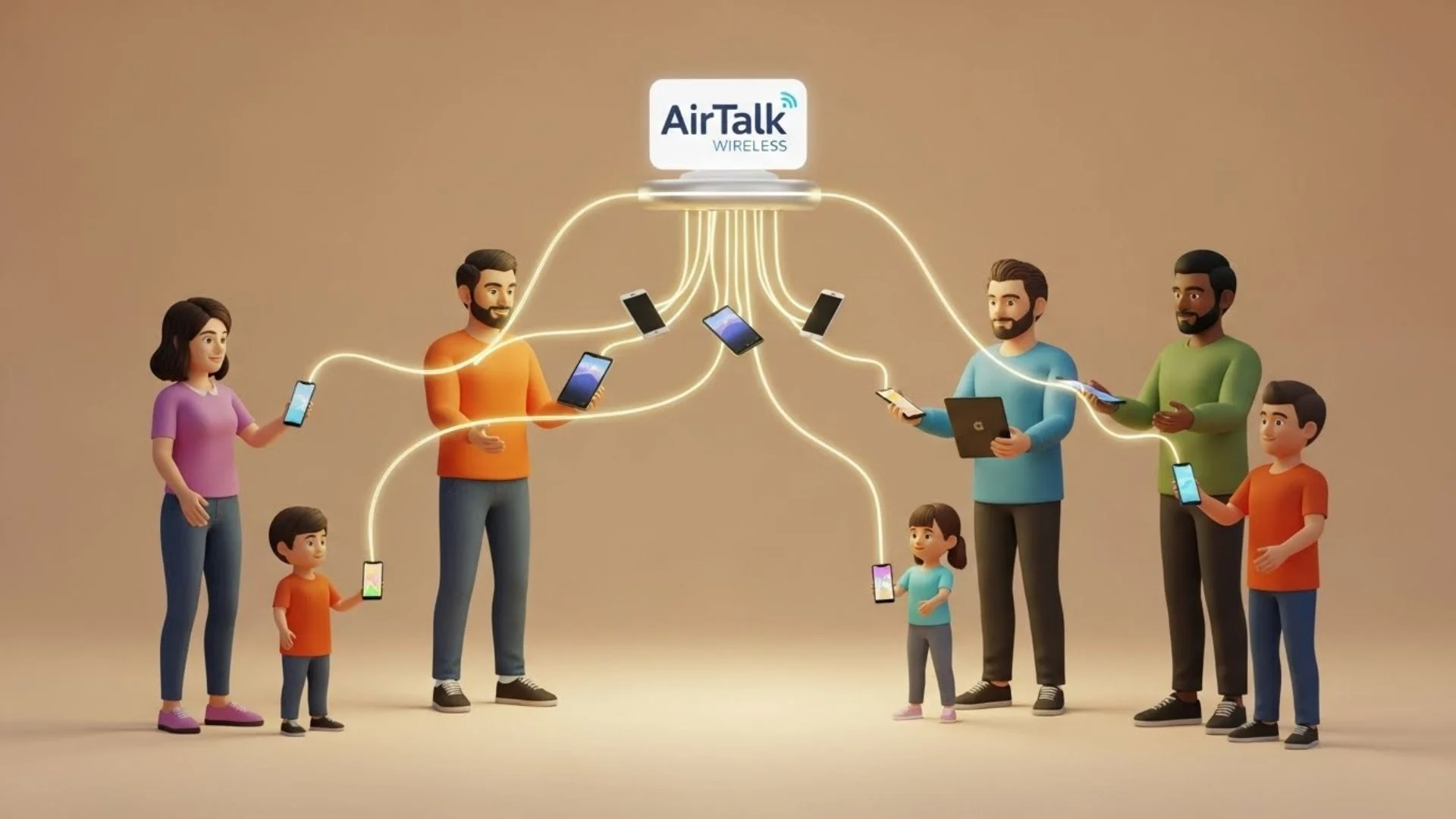Key Takeaways
- Both nandbox and Appy Pie are well-known no-code app builders, but they offer very different levels of app quality and capability.
- nandbox is a true native app builder that creates high-performance iOS and Android apps with 100+ built-in features, while Appy Pie mainly uses hybrid web-based app wrappers that limit speed, UX, and scalability.
- When it comes to functionality, nandbox provides built-in features like in-app chat, group messaging, bookings, payments, voice and video calls, and multilingual support, without needing extra plugins. Appy Pie, on the other hand, relies on simpler built-in modules and often requires add-ons or third-party tools for advanced features.
- In terms of AI, nandbox leads with AI app generation that builds full native apps in minutes, plus AI branding, feature recommendations, and ChatGPT-powered capabilities. Appy Pie offers basic AI design and layout assistance and converts prompts into starter app templates but still requires a lot of manual setup.
- On integrations and scalability, nandbox includes real-time two-way APIs and Bi-Directional WebSocket support for all plans at no extra cost. Appy Pie only offers advanced integrations through Appy Pie Automate, which comes with separate pricing and is mainly available on enterprise plans.
- When comparing value and long-term growth, Appy Pie is suitable for MVPs and quick prototypes, while nandbox is the stronger choice for building professional, fully featured, scalable native apps without coding.
nandbox vs. Appy Pie: Which No-Code App Builder is the Best?
Not all no-code app builders are the same; some leave you stuck with slow, basic apps, while others turn your idea into a native, full-featured, enterprise-ready app in minutes. So which no-code app builder is really worth your time in 2025: nandbox vs. Appy Pie?
On paper, both platforms promise to turn your idea into a fully functioning app without writing a single line of code.
But here’s the thing: One is great for prototypes and MVPs, while the other delivers native iOS and Android apps with built-in features, AI-powered capabilities, and enterprise-level scalability. The difference comes down to how these platforms actually build your app.
So the question is: Which no-code app builder is the best in 2025, nandbox vs. Appy Pie?
We tested both platforms hands-on to see which one actually delivers the best experience, functionality, reliability, and performance for users who want to build an app without coding.
So in this article, I will guide you through how to choose the best no-code app creators and compare the top app builders: nandbox vs. Appy Pie, across multiple factors, including
- Native vs. hybrid
- App performance, security, scalability, and offline access
- Pricing, free trials, and subscriptions
- AI-powered app generation and AI capabilities
- Design, branding, and customization
- App functionality and features
By the end, you’ll know exactly which no-code app builder actually helps you build faster, launch smoother, and scale without rebuilds or hidden limits, based on real hands-on testing, not just hype.
Platform Overview: Which No-Code App Builder Is Better, nandbox vs. Appy Pie?
When it comes to building apps without coding, both nandbox and Appy Pie are among the top no-code app builders. They both promise to help users build their dream apps without writing a single line of code. However, how they do it and the type of apps they actually create are completely different.
We tested both nandbox and Appy Pie hands-on to see how each one actually performs and what they offer beyond the marketing talk. nandbox runs on a true native architecture, which means faster performance, stronger security, and offline support that actually works without an internet connection. Appy Pie, on the other hand, relies on web-view architecture, which means slower performance, weaker security, and limited offline support. This native vs. hybrid difference mainly affects everything else.
So, let’s break down how nandbox vs. Appy Pie compares in terms of app type, performance, security, scalability, and offline support based on real testing results.
| Feature | nandbox | Appy Pie |
| No-code/Low-code | 100% No-code app builder | No-code app builder |
| App Type | True native iOS and Android app builder | Web-based/hybrid app builder |
| App and Web Support | iOS and Android native apps | iOS, Android apps, PWAs and websites |
| App Performance | Faster speed, performance, and seamless user experience | Slower speed and lower performance (depends on web-view performance) |
| App Security | More secure: Native-level encryption and isolated app architecture | Less secure: Web-based structure with limited security |
| Offline Access | Full offline support: Users can access all app features and data without an internet connection due to native iOS and Android components | Limited: Relies on web-view so most features require an internet connection |
| Global Architecture and Scalability | Enterprise-grade architecture: High-throughput platform with a distributed backend built to perform at large scale, runs on six global data centers with 99.999% uptime | Small-to-medium-scale architecture: Cloud-based system designed for small-to-medium-sized apps but lacks the distributed backend and high-throughput performance required for enterprise-grade scalability |
| Platform Support and OS Capability | Android 15-ready and iOS 18-compatible: Apps built with nandbox run on the latest iOS and Android versions. | Supports Android 7.0+ and iOS 13+ |
| Testing and Deployment | Free APK testing to validate your app’s performance and functionality on real devices before publishing | Basic testing and publishing support, but no free APK testing or real-device validation included |
| Best For | Almost everyone: beginners, startups, small and mid-sized businesses, enterprises, and anyone who want to build apps without coding | Prototypes, MVPs, and simple app ideas |
Overall, after hands-on testing, this nandbox vs. Appy Pie comparison shows that nandbox clearly outperforms Appy Pie in speed, security, scalability, OS capability, testing, and offline support. Since nandbox is a true native no-code app builder, it delivers enterprise-level scalability, the latest OS support, and free APK testing. That’s why nandbox is a more reliable choice for startups as well as enterprises. Appy Pie, on the other hand, is best suited for simple app ideas, MVPs, and prototypes.
Pricing Plans: Which No-Code App Builder Is More Affordable, nandbox vs. Appy Pie
When comparing the pricing plans between nandbox vs. Appy Pie, it’s important to look beyond the monthly fee. Pricing isn’t just about cost; it’s about the value you receive in return.
So the real question is: What do you actually get for that cost?
At first, Appy Pie may seem cheaper. But in reality, once you start adding essential features like white-labeling or even seeking professional support for building and publishing your app, those “affordable ” plans can easily double in price, making Appy Pie not as affordable as it may seem.
nandbox, on the other hand, may seem like it offers higher pricing plans, but in reality, everything is already included. nandbox offers full white-label publishing, which means you completely own your app and brand, unlike Appy Pie apps that require extra fees just to remove Appy Pie branding.
After reviewing both pricing plans thoroughly, let’s compare nandbox vs. Appy Pie in terms of pricing, included features, and paid add-on features that affect the total value you get from each platform.
| Feature | nandbox | Appy Pie |
| Free Trial | Available | Available |
| Free Trial Period | 7 days | 7 days |
| Credit Card Required | No: Doesnt require credit card for free trial activation | Yes: Requires credit card for free trial activation |
| Starting Plan | $59/month | $32/month |
| Middle Plan | $159/month | $72/month |
| Highest Plan | $359/month | $120/month |
| White Labeling Support | Free: Full white-label support for all plans | Paid Add-on: White labelling support available only through add-on package that cost double the pricing plan |
| Support | Premium: Professional support via emails, and online meetings for all plans | Limited: Support through emails for lower-tiers and calls for higher-tiers and premium support through add-on package that cost double the pricing plan |
| Special Plans | Available | Available |
| Special Offers | All plans are for $19.99 for the first month | Seasonal promotions |
After testing both platforms, this nandbox vs. Appy Pie pricing comparison shows that while Appy Pie may seem cheaper at first, nandbox offers far more value for the cost. nandbox pricing plans include full white-label ownership, premium support, and all native features. This makes nandbox a smarter long-term investment and cost-effective no-code app builder for anyone who wants to build enterprise-grade and professional apps affordably without coding.
App Design: Which No-Code App Builder Offers More Design Flexibility, nandbox vs. Appy Pie?
Design is where your app makes its first impression, and to be honest, users don’t stick around apps that have outdated design and limited accessibility. That’s why your app design can determine your app’s success. Both nandbox and Appy Pie offer design customization. However, app customization isn’t just about colors and themes; it’s also about accessibility, brand consistency, and following modern UI/UX standards.
So the real question is: Which no-code app builder gives you more design freedom, nandbox vs. Appy Pie?
Both nandbox and Appy Pie offer drag-and-drop interfaces and ready-made templates. The real difference shows up when it comes to brand consistency, accessibility, UI customization, and both Google Material Design guidelines and Apple Human Interface guidelines compliance.
We tested both platforms hands-on, so let’s find out how nandbox vs. Appy Pie compares when it comes to app design, customization, accessibility, and branding.
| Feature | nandbox | Appy Pie |
| Drag-and-Drop App Builder | Available | Available |
| Pre-Made App Templates | Available | Available |
| App Templates Variety | High, with 60+ industry-specific app templates covering music, e-commerce, communication, booking, education, and more | High, with broad category coverage across music, e-commerce, events, booking, and more |
| Material You and iOS HIG compliance | Available: Follows the latest Google’s Material Design (M2 & M3) and Apple’s Human Interface Guidelines | Not Available |
| Light and Dark Mode Support | Available: Built-in light and dark modes with toggle switch that meet accessibility and contrast standards for both iOS and Android | Limited: Requires manual setup to create a seperate theme with no automatic light or dark mode switching (not built-in) |
| Accessibility and Branding | Accessible: Brand-consistent UI with modern color schemes and themes that follow WCAG contrast best practices for readable, visually appealing, and professional interfaces. | Limited: Doesn’t fully meet WCAG contrast best practices with only basic accessibility settings available |
| App Simulator | Available: Real-time visual app simulator to see app changes during building with theme switching (light/dark) | Available: Live preview web simulator to see changes while building the app |
| Automatic App Branding and Theme Customization | Available: AI-powered app design that generates complete app branding, layouts, and structure using logo and brand palette for consistent and professional UI | Available: AI design assistant that generates app design, layouts, and structure |
| Splash Screen Customization | High: Users can choose from 7 customizable splash screen templates and customize colors, text, images, and buttons for both iOS and Android apps | High: users can create splash screens automatically using a splash screen generator |
| AI-Powered Photo Generation | Available: Supports AI photo generation for icons and in-app images | Not Available |
| AI-Branding Customization | Available: AI-powered branding that auto-generates app colors, themes, layouts, and icons based on user input | Available: AI design assistant that suggest app themes, colors, and icons |
This nandbox vs. Appy Pie comparison shows that nandbox clearly offers more professional design control with Material YOU and HIG-compliant UI, built-in light and dark mode accessibility support, and AI-powered branding. Appy Pie, on the other hand, offers basic customization features and branding but doesn’t follow modern UI/UX standards or accessibility best practices.
AI-Powered App Generation: Which No-Code App Builder Offers the Best AI App Generation, nandbox vs. Appy Pie?
AI is now a big part of app building, and in 2025, most people are searching for the best AI-powered app builder. The thing is, not every “AI App Builder” actually helps you build fully functional, ready-to-launch apps.
Some AI app builders only help you with colors, layout, and basic app structure. On the other hand, other AI-powered app builders generate full-featured, ready-to-launch apps that are complete with all the features, screens, and even AI-generated images that match your app. So when comparing the AI capabilities of nandbox vs. Appy Pie, it’s important to understand what the AI does, not just what the platform claims it can do.
So the real question is: Which no-code app builder truly helps you build your app faster with AI, nandbox vs. Appy Pie?
Both platforms offer AI support, but the difference becomes clear when it comes to AI app generation, feature recommendations, branding, and how much the AI reduces the manual work for you.
We tested both platforms hands-on, so here’s how nandbox vs. Appy Pie compare when it comes to AI-powered app building and automation.
| AI Features | nandbox | Appy Pie |
| AI App Generation (Idea to App) | Available: nandbox is the only AI app builder that transforms ideas into ready-to-launch native apps. | Partially available: It converts text prompts into basic app layouts and structures |
| ChatGPT App Generation | Available: nandbox App Builder GPT transforms ideas into ready-to-launch native apps. | Not Available |
| ChatGPT Integration | Available: Through API integrations, which lets you add ChatGPT AI features like chatbots, translations, and AI workflows to your app | Available: Through Appy Pie automate, which lets you connect ChatGPT with your app for AI-powered automation and chat features |
| AI Assistant | Available: Gives a guided walkthrough of the app builder and explains each feature and section | Available: The Text-to-Design feature suggests app layouts, designs, and branding |
| AI Feature Recommendations | Available: Suggests features, components and modules automatically based on app type | Limited: AI suggests basic app structure, but users manually add features using drag-and-drop. |
| AI Content and Photo Generation | Available: AI-powered photo and content generation for app icons, layouts, and in-app images | Not Available |
| AI Branding and Design | Available: AI-powered app design that generates complete app branding, layouts, and structure using logo and brand palette for consistent and professional UI | Available: AI design assistant that generates app design, layouts, and structure |
| Other AI Capabilities | Available: Extracts app colors from logos, builds full branding themes and designs, and automate workflows | AI agents: Help automate workflows and third-party integrations |
Overall, after thorough testing of both app builders, this nandbox vs Appy Pie comparison shows that nandbox clearly outperforms Appy Pie in AI-powered app generation. nandbox offers a more advanced AI app builder with full idea-to-app generation, AI branding, feature recommendations, and even native app publishing support. Appy Pie, on the other hand, offers basic AI app capabilities with some AI tools for layouts and design. That’s why nandbox is the smarter choice if you want to build a complete, ready-to-launch app faster using AI without coding.
App Functionality: Which No-Code App Builder Has More Built-In Features, nandbox vs. Appy Pie
When it comes to app functionality, not all app builders are the same. Your app’s performance, reliability, security, and even scalability depend on whether it’s built with true native components or hybrid web-based components. nandbox uses native iOS and Android features to deliver fast and high-quality performance. Appy Pie, on the other hand, relies on hybrid wrappers and web-based components that deliver limited functionality, responsiveness and overall performance.
Another main difference is API integrations. nandbox offers Bi-Directional WebSocket APIs, which means that Your app can send and receive data in real time with other systems, like your CRM, databases, or external services, instantly without delay. Appy Pie only provides this level of functionality for enterprise-level plans through Appy Pie Automate, which makes advanced integrations less accessible for most users.
We tested both platforms hands-on, so you can see exactly how nandbox vs. Appy Pie compares when it comes to built-in features, functionality, and API integrations.
| App Functionality | nandbox | Appy Pie |
| Feature Type (Native vs. hybrid) | True native components for Android and iOS. | Hybrid wrapper (WebView-based, not true native) |
| Built-in App Features | +100 Built-in and ready-to-use native app features | Offers common business features like booking, maps, and forms |
| In-App Chats and Messaging | Available: Native all-in-one messenger with end-to-end encrypted chats | Available: Messenger with one-on-one chats |
| Group Chats | Available: Large group chats that can hold up to 50,000 users | Available |
| Voice Calls | Available: High-quality voice calls using built-in native VoIP functionality | Not available |
| Video Calls | Available: High-quality video calls using built-in native VoIP functionality | Available: Offers video conferencing feature |
| Push Notifications | Available: Unlimited push notifications for all plans | Available: Limited push notifications based on the selected pricing plan |
| Bookings and Appointments | Available: Built-in booking system with calendar integration | Available: Offers scheduling feature |
| Built-in Payments | Available: Offers secure payments, including credit cards, debit cards, Stripe and PayPal | Available: Offers multiple payment gateways including Stripe and PayPal |
| Maps and Location Services | Available: Built-in Maps with GPS integration | Available |
| Multilingual Support | Available: Built-in multiple language support, including English, German, Spanish, French, Italian, Arabic, Portuguese, and Chinese | Available: Multiple language support, including Arabic, Hebrew, English, German, French, Chinese, and more |
| API Integrations | Available: Real-time full-duplex APIs included for all plans without extra cost, to enable seamless integrations with external systems | Available as a paid add-on: Through Appy Pie Automate with seperate pricing plans that are billed annually |
| Two-Way API Integrations | Available: Bi-Directional WebSocket APIs for real-time two-way communication, low-latency data synch, event streaming, and in-app messaging without requiring third-party plugins | Limited: Only available for Enterprise-level Appy Pie Automate plans |
| Admin Tools and Access Control | Available: Powerful web dashboard with granular roles, audit logs, and multi-team management for safe, secure, and scalable business operations | Limited: Basic admin dashboard with general user roles and permissions |
| Custom SDKs Support | Available: Developer-friendly SDKs for Java, JavaScript, and Python that can be integrated quickly with existing systems and workflows | Not Available |
After testing both platforms, this nandbox vs. Appy Pie comparison shows that nandbox clearly stands out in app functionality, as it offers true native iOS and Android features, Bi-Directional WebSocket APIs for real-time two-way integrations with CRMs and external systems, a built-in messenger with voice and video calls, multilingual support, and scalable admin tools. Appy Pie relies on hybrid wrappers and enterprise-only integrations, which make its functionality limited. Overall, nandbox is the smarter choice for professional and enterprise-level apps.
Final Thoughts: Which No-Code App Builder Is Better, nandbox vs. Appy Pie?
At the end of the day, choosing the best no-code app builder isn’t just about who has the most features on paper; it’s about who can actually help you build a fast, secure, scalable, and fully functional app that users will love. After testing both nandbox and Appy Pie, the difference became clear. Appy Pie works best for prototypes, MVP, and for testing simple app ideas. But, if you’re looking for native app performance, speed, security, salability, powerful AI capabilities, and advanced APIs without paying enterprise-level prices, then nandbox is your go-to solution.
If you’re serious about building an app that feels professional, performs like the giant native apps that we use daily, and doesn’t limit you as you grow, nandbox no-code app builder is the smarter solution. In other words, nandbox gives you way more value and long-term potential.
So What are you waiting for? Start building your app straight away with no credit card needed and see the difference for yourself!
FAQs: How to Choose the Best No-Code App Builder, nandbox vs. Appy Pie?
How can I build an app without coding?
You can build an app without coding using no-code app creators like nandbox. nandbox lets you create native iOS and Android apps in just minutes using a drag-and-drop interface, pre-made app templates, ready-to-use features, and AI-powered app generation.
How do I choose the best no-code app builder?
First, define your app’s purpose, features, and audience. Then compare platforms based on what type of apps they build (native vs. hybrid), pricing, design flexibility, and AI support. For example, nandbox is ideal if you want a native, scalable, AI-powered app builder for both iOS and Android.
How do I publish my app on the App Store and Google Play without Coding?
No-code app makers like nandbox handle publishing for you. Once your app is built, you can use your Apple Developer and Google Play Console accounts to publish directly, all from within the platform without any coding required.
How much does it cost to build an app without coding?
No-code app creators typically offer subscription-based plans that range from $30 to $300 per month, depending on features and usage. With nandbox no-code app builder, you can create your app for less than $100. nandbox provides transparent pricing with no hidden fees, plus a 7-day free trial to help you test the platform before committing.
Is white-label branding included or an extra cost with Appy Pie?
White-labeling with Appy Pie is a paid add-on with double the pricing plan cost. But with nandbox, full white-label branding is included in its plans, so you own your app and brand from day one.
Can I integrate my app with CRM, databases or external systems in real time using Appy Pie?
Appy Pie allows integrations via Appy Pie Automate, which has separate pricing plans, but real-time two-way data sync is only available with enterprise-grade plans. nandbox, on the other hand, provides bi-directional WebSocket APIs and real-time full-duplex integrations across all plans for seamless two-way communication.
Does Appy Pie offer voice calls, video calls, and group chat features?
Appy Pie supports basic messaging and video conferencing features, but voice calls and large-scale group chats are more limited. If you want to build a true native app that supports voice calls and video calls, nandbox is your best choice. nandbox offers a built-in messaging platform with end-to-end encryption, voice & video calls, and large group chats for up to 50,000 users.
